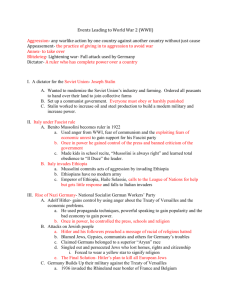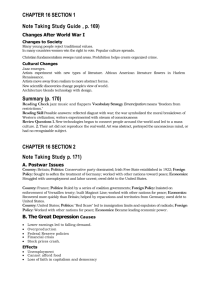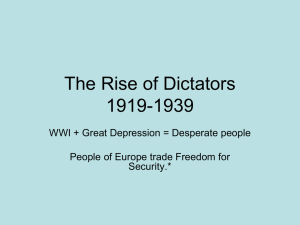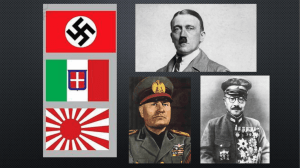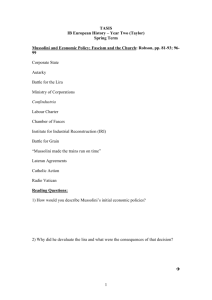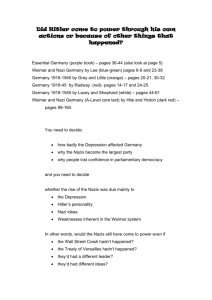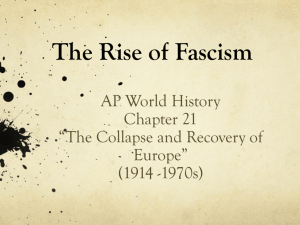Fascist Dictatorships in Italy and Germany
advertisement
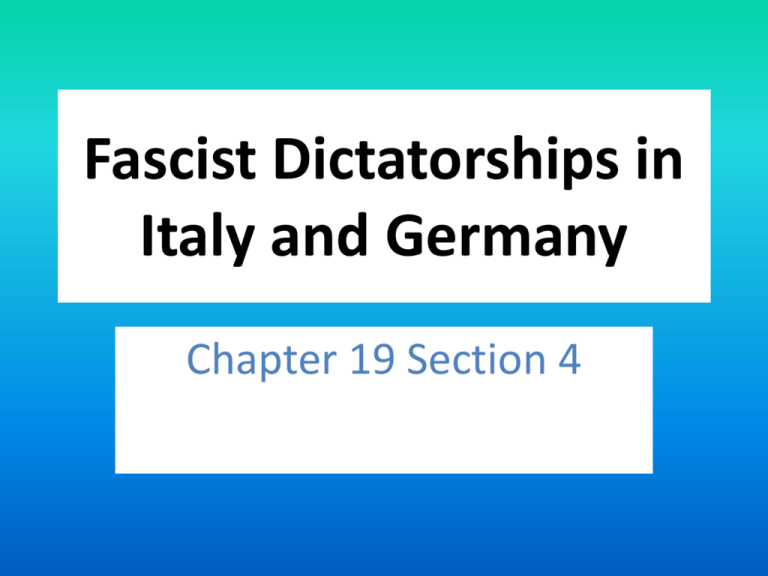
Fascist Dictatorships in Italy and Germany Chapter 19 Section 4 The Rise of Fascism in Italy • Italy Constitutional Monarchy –Trouble transitioning after WWI. • Benito Mussolini – extreme nationalist –Created Fascist Party • Fascism – doctrine (bundle of rods bound tightly, symbolizes authority of government). The Rise of Fascism in Italy (cont.) • Fascist doctrine –Dictatorship/totalitarianism –Strongly nationalistic and militaristic –Anti-communism and democracy –Upper class appeal • Maintain social classes The Rise of Fascism in Italy (cont.) • Followers nationalists, WWI soldiers, eventually shopkeepers, wealthy landowners. ($) • Used anti-communism to gain support. –Protection of private property & middle class. Mussolini’s Rise to Power • Violent campaign • Black Shirts used intimidation and force. –Oct. 1922 – met in Rome (defend against communist revolution) • Parliament resigned • King appoints Mussolini premier (head of coalition government.) Mussolini’s Rise to Power • Mussolini’s Goal – Destroy democracy, create dictatorship • Appointed fascists to official positions • Fascists won election 1924 – 1925 Mussolini – “head of the government” – King – no power, stayed king • Mussolini – Controlled Ministry of War, police. Mussolini’s Rise to Power • In power: – Disbanded opposing political parties – NO Freedom of Speech, Freedom of the Press, NO trial by jury – Outlawed strikes – Secret Police (spies) • Italy police state. Mussolini’s Rise to Power • Corporatist state – economic activity determined representation – Agriculture, commerce, manufacturing, transportation • 1934 22 corporations formed – Work for the benefit of the government – Govt establish wages, hrs., conditions Germany The Weimar Republic • Became Weimar Republic in 1919. –Citizens angry because they signed the Treaty of Versailles – traitors. –High unemployment –Inflation (no #’s) –Adolf Hitler – used frustrations to gain support for his political party - Nazis The Nazis and Hitler • Nazi Party (National Socialist German Workers’ Party). –Nationalistic, anti-Semitic, anticommunist. –Promise- protection from communism. –Wealthy supporters The Nazis and Hitler (cont.) • 1921 Hitler – head of Nazi Party –Imprisoned for uprising (Beer Hall Putsch) • Wrote Mein Kampf (“my struggle”) –Spirit of Nazi movement. –Plan – racial purity – execute all Jews. –1927 active discrimination of Jews increased in violence. The Nazis and Hitler (cont). • Popular speech giver. –Promises: • Repeal Treaty of Versailles • Restore military power • Recover lost territory • Build a “Greater Germany” • Racial purification The Nazis in Power • 1925 25,000 members by 1929 180,000 members • Bad economy Nazi Party supporters in the 1930 election. –1932 230 seats in Reichstag (German parliament), more than any other party. • 1933 – Hitler appointed chancellor The Nazis in Power (cont.) • Used scare tactics to frighten Reichstag made himself dictator. – der Führer (“the leader”) • Germany – police state – Banned labor unions, censored newspapers, eliminated other political parties. – Gestapo – secret police force – lots of power The Nazis in Power (cont.) • Persecution of “inferior races” • Jews – forced to live in ghettos (separate neighborhoods) • Jews – had to wear Star of David – Political opponents sent to concentration camps. – Concentration Camps – initially work camps/ isolate people. • Later extermination of millions of Jews The Nazis in Power (cont.) • Promise – revive economy • Called his rule Third Reich (third empire) • Said it would last 1,000 yrs. – 1930’s secretly rebuild military – Early 1936 – sent troops to Rhineland (violation of Treaty of Versailles.) • No one reacted – not worth war – Fall 1936 allied with Mussolini • Rome-Berlin Axis


